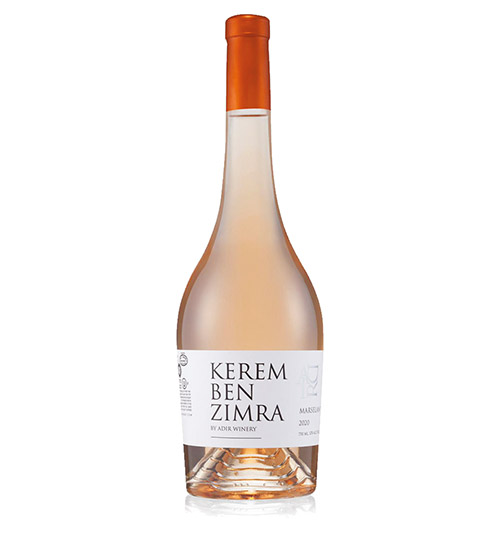

If you peruse the shelves of your local wine shop, you would be forgiven if you don’t recognize many of the grape varietals listed on the labels. The selection of domestic and international kosher wines available to the local consumer is the greatest it has ever been, providing for adventurous experiences, but also causing befuddlement and consternation when the wrong bottle is brought home. Most everyone is familiar with cabernet sauvignon and chardonnay and can properly identify the former as red and the latter as white, but many other grapes, such as marselan, remain a mystery to the average shopper.
Adir marselan and Adir marselan rosé may call to mind the fortified Sicilian cooking wines commonly used as a key ingredient in the famous dish chicken marsala. Yet in contrast to marsala, marselan-based wines, particularly from Israel and other wine “New World” regions, are considered fine wines. So, what’s their story?
In the early 1960s, France’s National Institute for Agricultural Research (INRA) attempted to develop new high-yielding, large-berry-producing varietals by cross breeding disease-resistant vines at the École Nationale Supérieure Agronomique de Montpellier (ENSAM), Europe’s premier vine-research institute. While the INRA researchers succeeded in harnessing the finesse of Cabernet Sauvignon with the color, heartiness and hot-weather tolerance of Grenache, they were disappointed at the small grape berries of the new vine, which they had named in honor of the costal Occitan commune (town) of Marseillan. As a result, INRA deemed the strain commercially unattractive and promptly forgot about it.
By the mid to late 1980s, growing concern over hypothetical agricultural upheavals due to climatic changes led researchers to revisit the vine’s potential. Warmer temperatures, increased humidity and a longer rainy season likely would harm grape varieties that heretofore had thrived in cooler temperatures. Further, lengthening of the rainy season could lead to fungal infections of vine leaves and grapes and harm wine production. Marselan’s previously noted resistance to powdery mildew was especially attractive, since farmers would not need chemical fungicides to combat the costly fungal disease that affects plants in areas with moderate temperatures and high humidity. As a result, the INRA approved the vine for commercial release and added it to France’s official register almost 30 years after it was first developed.
Marselan vine planting rapidly spread from France’s warmer south to other hot regions in Spain, Latin America, California, China and elsewhere. Vintners introduced the vine to Catalonia, Spain, across the Pyrenees Mountains from Languedoc, in 1990, and today Marselan vineyards can be found as far south as Valencia. The vine’s second largest harvester, China, began planting Marselan in 2001. Argentinian farmers in Mendoza began working with the grape in 1998, joined in the following decade by their peers in Brazil and Uruguay. Growers in California’s Central Valley and North Coast regions adopted the grapes in 2004. Switzerland, Romania and other countries have also encouraged plantings. By 2007, the Treasury Department’s Tax and Trade Bureau, which regulates sales and imports of alcohol, approved the name “Marselan” for use on labels, allowing imports of single varietal wines, initially from France. In 2011, France permitted Marselan to be used up to a maximum of 10% in appellation specific (appellation d’origine controlee – “AOC”) blends from Côtes du Rhône and Bordeaux, marking the vines acceptance into the highest reaches of French winemaking.
Unsurprisingly, the fast-growing and innovative Israeli wine industry, constantly searching out high-quality European varietals capable of producing top-shelf wines in the hot and humid local climate, took notice. Israel is now among the top three Marselan wine producers when measured by availability.
As mentioned earlier, Adir Winery has taken a lead, planting its Marselan vineyard in 2016 in the Upper Galilee moshav of Dishon, on the border with Lebanon, roughly 10 miles northeast of the winery’s main vineyards at Kerem Ben Zimra. Following the customary three-year wait for orlah, the winery released its first Marselan Rosé in 2020, meeting with immediate success and selling out quickly. The freshly pressed juice sits on the skins for scarcely two hours, until it has absorbed just enough color. The rosé is cold fermented for 40 days to preserve the wine’s aromas, reaching 12% alcohol by volume (ABV). Adir doubled rosé production for the 2021 vintage, which has just arrived in time for spring.
Additionally, the winery released a limited production of Winemaker Edition Marselan 2020. This series allows winemaker Avi Rosenberg to highlight the unique aspects of the Adir’s estate-produced fruit, by utilizing 500-liter barrels that minimize wood contact. Only 1,100 bottles of this vintage were produced.
Here are our initial reactions upon sampling both wines:
Adir Kerem Ben Zimra Marselan Rosé 2021, Galilee: Light pink in color, with crisp floral and strawberry aromas, this wine entices you to sip. Flavors of wild strawberry, red grapefruit and hints of lychee tease your tongue with a light mouthfeel and pleasant acidity.
Adir Winemaker Edition Marselan 2020, Galilee: Inky purple/red in color, with a nose of red cherry, tobacco and a hint of leather. On the tongue, the wine is fruity, with cherry, blackberry and plum flavors, reminiscent of Cabernet Sauvignon, but mid-bodied. Despite its youthfulness, the wine is well balanced, with integrated tannins and acidity. Surprising for a wine of 14% ABV, it has no heat. A young wine, you should decant it a half hour before consuming. It will continue developing in the bottle for the next 5 to 6 years.
Teaneck’s Shimon Oppenheim works for Red Garden Inc., importers of Adir Winery.










